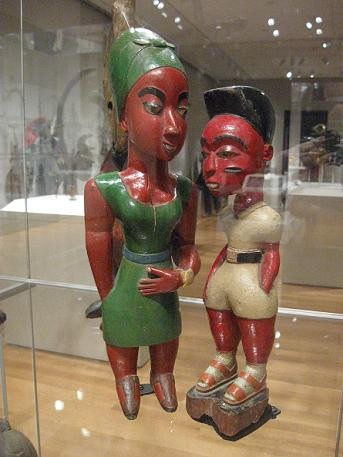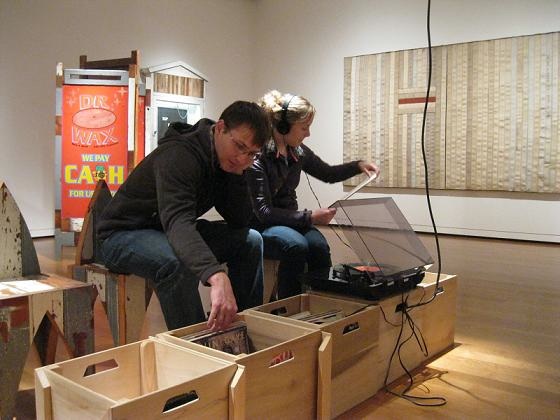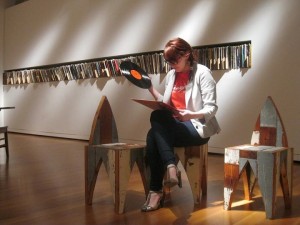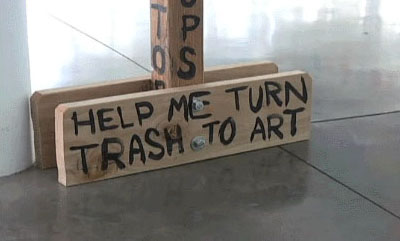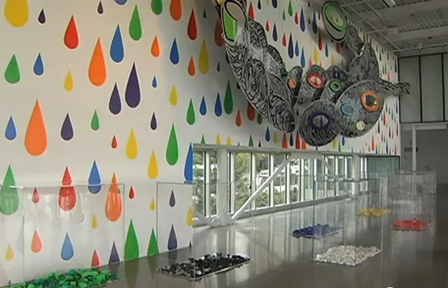Two Sculptural Pair & A Next 50 Affair
There is a display in SAM Downtown’s Wright & Runstad Gallery for African Art holding two pairs of sculptures that provide a transcendent view of “togetherness” and what it means for the spiritual to be connected with the earth. The first is a pair of “Male and Female figures” made by the Baule of central Cote d’Ivoire. The painted wood sculptures represent spirit spouses that inhabit another world parallel to this one, and are prescribed by diviners to promote a healthy living situation between spouses. Imbued with power by the diviner each sculpture is given individual attention by its client in order for the power to be activated. Beside this pair resides a set of Congolese harps carved with faces at the end of their long curving necks to keep their players company and watch their every move. Atop flexed, carved legs their bellies would be filled with sound as the harp couple was played by two musicians travelling as a pair. During their travels the performers recited history as their livelihood and sang legendary epics.
Taken together these objects bring to mind the exhibit Theaster Gates: The Listening Room where objects form a collective history and repurposed materials find new meaning as art. The collection of records taken from Chicago’s now defunct Dr. Wax record store reminds me of the spirit spouses who are deserving of more attention. Giving attention to the records in SAM’s twice monthly DJ sets in the Listening Room (come listen next week May 3 & 6!) has allowed people in our community to come together at SAM through music. Although the spirit spouses must be decommissioned of their power by the diviner before they enter the museum the enduring coolness in their expressions continues to give meaning to their remedial function. Similarly the decommissioned fire hoses lining the walls of the Listening Room evoke memories of the civil rights movement in the 1960s where protestors were sprayed with these high pressure hoses during race riots. Our collective memory is jarred by Theaster Gates who saw value in an art object where others saw scrap material.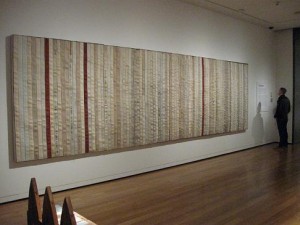
Considering this communal environment brings up another project Theaster Gates is involved with – the upcoming performance of “red, black & GREEN: a blues” coming to the Intiman Theater for Seattle Center’s Next 50 festival 30 May – 2 June. The performance is collaborative and interactive, written for the stage by performer, activist, and educator Marc Bamuthi Joseph. Bamuthi is working with a host of talented artists including set design by Gates. Click here to learn more about Marc Bamuthi Joseph and the Living Word Project and watch videos on the performance “red, black & GREEN: a blues.”
The central question addressed by Bamuthi is, “what sustains life in your city?” This is something he asked many people through the Life is Living festivals he has curated since 2008 in various U.S. cities and forms the inspiration that went into writing “red, black & GREEN: a blues.” By incorporating “the voices of people often left out of discussions about living green,” this conversation on the environment succeeds where others have fallen short, and actively seeks a reimagining of where we place value in our community.[i] This forms a collective experience that, through the stories Bamuthi has engaged and the recycled materials of Theaster’s set inspired by row houses, express our social ecology with power, grace, and rhythm. The success of this performance comes from the belief that “ultimately we are interdependent and stronger through collaboration,” which, like the Congolese harps and Ivorian spirit spouses, helps us maintain good relations and feel connected with the earth.
-Ryan R. Peterson, Curatorial + Community Engagement Intern
[i] Source: Mapp international productions website. Artist proframs, artists and projets, Marc Bamuthi Joseph, red, black & GREEN: a blues. Last accessed 24, April, 2012. http://mappinternational.org/programs/view/214
Top photo: “Male and Female Figures,” wood, paint, Ivorian, Baule & “Pair of Harps,” wood, skin, fabric, Congolese, Ngbaka. Photograph by the Author. Taken 4/24/12. JPEG file.
